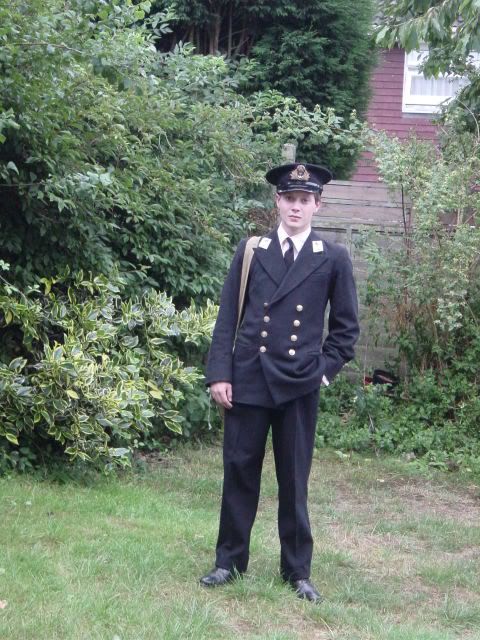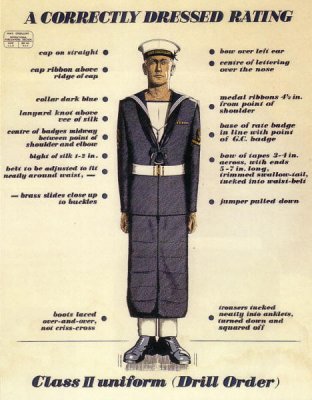Cobden
Practically Family
- Messages
- 788
- Location
- Oxford, UK
Unlike the Army, uniforms of the Royal Navy did not undergo anywear near as many changes through the war as the army. However, this is counteracted by the number of uniforms that existed! There were four different uniform types depending on rank and rate: Officers, Class I (CPO's), Class II (Rating's Dressed as Seamen AKA Square Rig), and Class III (Petty Officers of Six Months Experience or Confirmed in that positions, and Rating's not dressed as seamen such as Stewards, Cooks, Sick Berth Attendents). Dealing with the officers later, the Class I and Class III ratings wore very similar uniforms, the only difference being that Class I ratings wore their trade on their collars, whilst Class III wore the rank and ratings on their sleeves. Both Classes wore six button double breasted serge jackets and ordinary trousers, with a peaked cap and a shirt and tie.
Class II ratings wore square rig consisting of Bell Bottomed Trousers (with five or seven horizontal creases, and verticle creases at the sides of the trousers, pressed inside out so creases point inwards), a jumper with either gold or rank & trade insignia depending on order of dress (supposedly, gold insignia was stopped at the beginning of the war. In pratice they pretty much all got hold of them), again pressed inside out, collar which was tied around the waist under the jumper with three creases forming a W on the back (although many found it didn't blow up as much if pressed into a M), a blue top or white top peakless cap with HMS tally tied around it with a bow above the right eye (not regulation, but everyone did it), a blue jersey or white T-shirt like "flannel" or "white front" was worn under the jumper. Around the neck, over the jumper but under it's neck flap was a black silk - a square of material folded seven times and sewn at one end to form a loop of material. This was tied at the front in a bow by a cotton tape. A white lanyard was underneath the neck flap of the Jumper, looped around the silk, and then inside the jumper. Black, toecapless and unhobnailed boots were worn. In the UK blue topped caps all year round, with a white front worn in summer, a blue jersey in Winter. Square rig was also worn with a white top cap and a white front in Winter in the Mediterranean.
It is probably now best to examine Royal Navy orders of dress, which were numbered as such:
Ratings:
No 1 Best serge suit, gold badges,medals.
Occasions: Inspection, Ceremonial, Sundays in harbour, long and short leave.
Class I wore a six brass buttoned double breasted uniform with gold trade insignia on the collar and CPO's rank insignia (consisting of three horizontal buttons) on the cuffs. In 1943, when, due to wool shortages, this was replaced with a four buttoned single breasted uniform. Class III wore similar, but with gold insignia on the sleeves, with brass buttons. Class II ratings in the UK wore square rig as described above, with gold rank and trade insignia. The lanyard was not worn when parading with rifles. In 1942, the jumper changed from having button cuffs to have plain cuffs.
During wartime, medals were not worn, but medal ribbons were.
For this uniform, it was very common for sailors to have a suit made up in a tailors (known as a "tiddly suit") with non-regulation features such as silk linings, overlarge bell bottoms, etc. for walking out.
No2 Second best serge suit, red badges, medal ribbons.
Occasions: Dutymen, boats crews, Sundays at sea, optional on leave on week days.
Same as above, but with red insignia replacing gold. Class III ratings (excluding Petty Officers) wore black bakelite buttons as opposed to brass, and a red cap badge.
No3 Serge suit, red badges, optional medal ribbons.
Occasions: On working days for all ordinary occasions.
Class I/III: Single Breasted Four Button Uniform (although three button uniforms were introduced 1944 onwards) - Class III (excluding PO's) wore black buttons, Class I and PO's wore brass. Class II generally didn't wear a lanyard with this rig.
No3a: Air Branch blouse
"Battledress". This was only worn by ratings in the Air Branch (AKA the Fleet Air Arm) and was introduced in 1943. I've never seen one being worn in photographs, so I can't really comment on this.
No4 Serge suit, red badges.
Occasions: For night clothing and in wet weather.
Same as above, except that jersey could be worn in summer, and a collar wasn't worn.
No5 Drill suit, medals.
Occasions: In place of No.1s when whites (tropical uniforms) are being worn.
Class I: white single breasted, stand collar uniform with brass buttons and two unpleated patch pockets without flaps on the breast (like normal shirt pockets), white trousers, white canvas shoes, cap with white cover. Trade was gold, and worn above the buttons on the cuff, if worn at all. Class III similar, but with blue insignia on the sleeves. Class II wore a blue version of the square rig, with blue denim "hemming" at the bottom of the jumper and at the ends of the cuffs. Worn with a white front and a white topped cap. A seperate collar wasn't worn, as the collar on the jumper mimicked the seperate collar worn with the temperate uniform. This was worn with white bell bottoms and white, canvas shoes. Trade and rating insignia was blue.
No6 Drill suit, medal ribbons.
Occasions: In place of No.2s when whites are being worn.
Same as above, except Class III wore black buttons and red cab badge as opposed to brass and gold respectively.
No7 (irrelevent to WWII)
No8 Blue overalls.
Occasions: For particularly dirty work.
Either single piece or two piece overalls, worn with either a white front, blue jersey, or undershirt by all ratings. Often worn at sea in WWII, especially on small ships. Blue or white top depending on location. Very informal
No9 Tropical singlet, shorts and caps, long blue socks.
Occasions: As ordered in tropical waters.
Class I: white shirt with two breast pockets, white shorts, white socks, white canvas shoes, cap white white cover. Class III but with black boots and socks, unless a Petty Officer in which white shoes and socks are worn. Class II wore the white front, white shorts, white topped cap, black boots and socks (unless a PO). Rank sometimes worn in blue on left sleeve.
No3, class II, summer in the UK
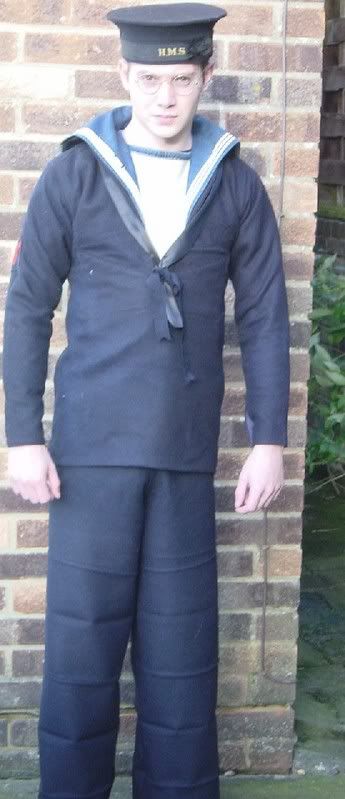
And winter
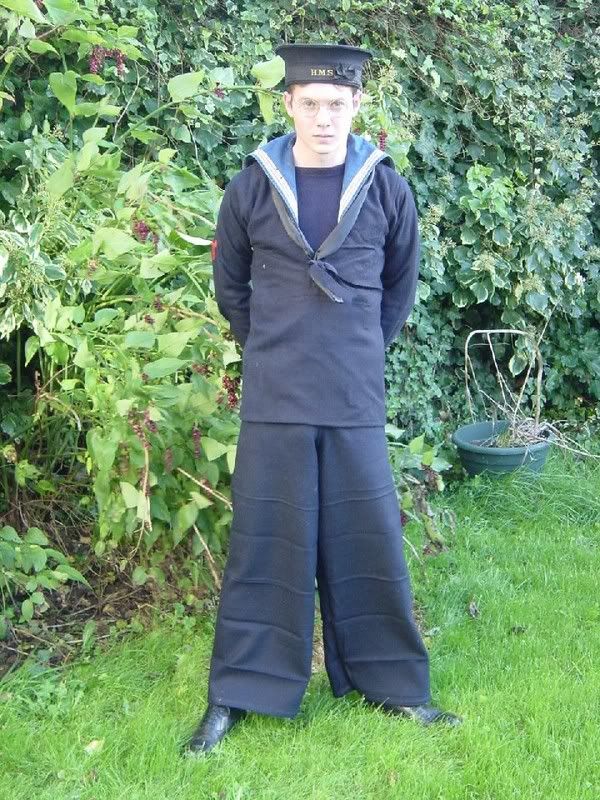
No1. Class III (petty Officer)

No8 (right), and a Wren:
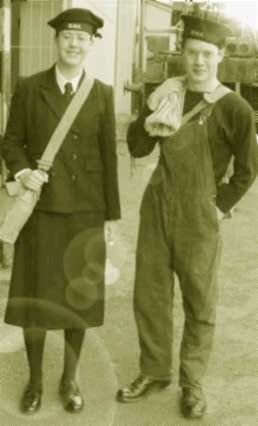
Class II ratings wore square rig consisting of Bell Bottomed Trousers (with five or seven horizontal creases, and verticle creases at the sides of the trousers, pressed inside out so creases point inwards), a jumper with either gold or rank & trade insignia depending on order of dress (supposedly, gold insignia was stopped at the beginning of the war. In pratice they pretty much all got hold of them), again pressed inside out, collar which was tied around the waist under the jumper with three creases forming a W on the back (although many found it didn't blow up as much if pressed into a M), a blue top or white top peakless cap with HMS tally tied around it with a bow above the right eye (not regulation, but everyone did it), a blue jersey or white T-shirt like "flannel" or "white front" was worn under the jumper. Around the neck, over the jumper but under it's neck flap was a black silk - a square of material folded seven times and sewn at one end to form a loop of material. This was tied at the front in a bow by a cotton tape. A white lanyard was underneath the neck flap of the Jumper, looped around the silk, and then inside the jumper. Black, toecapless and unhobnailed boots were worn. In the UK blue topped caps all year round, with a white front worn in summer, a blue jersey in Winter. Square rig was also worn with a white top cap and a white front in Winter in the Mediterranean.
It is probably now best to examine Royal Navy orders of dress, which were numbered as such:
Ratings:
No 1 Best serge suit, gold badges,medals.
Occasions: Inspection, Ceremonial, Sundays in harbour, long and short leave.
Class I wore a six brass buttoned double breasted uniform with gold trade insignia on the collar and CPO's rank insignia (consisting of three horizontal buttons) on the cuffs. In 1943, when, due to wool shortages, this was replaced with a four buttoned single breasted uniform. Class III wore similar, but with gold insignia on the sleeves, with brass buttons. Class II ratings in the UK wore square rig as described above, with gold rank and trade insignia. The lanyard was not worn when parading with rifles. In 1942, the jumper changed from having button cuffs to have plain cuffs.
During wartime, medals were not worn, but medal ribbons were.
For this uniform, it was very common for sailors to have a suit made up in a tailors (known as a "tiddly suit") with non-regulation features such as silk linings, overlarge bell bottoms, etc. for walking out.
No2 Second best serge suit, red badges, medal ribbons.
Occasions: Dutymen, boats crews, Sundays at sea, optional on leave on week days.
Same as above, but with red insignia replacing gold. Class III ratings (excluding Petty Officers) wore black bakelite buttons as opposed to brass, and a red cap badge.
No3 Serge suit, red badges, optional medal ribbons.
Occasions: On working days for all ordinary occasions.
Class I/III: Single Breasted Four Button Uniform (although three button uniforms were introduced 1944 onwards) - Class III (excluding PO's) wore black buttons, Class I and PO's wore brass. Class II generally didn't wear a lanyard with this rig.
No3a: Air Branch blouse
"Battledress". This was only worn by ratings in the Air Branch (AKA the Fleet Air Arm) and was introduced in 1943. I've never seen one being worn in photographs, so I can't really comment on this.
No4 Serge suit, red badges.
Occasions: For night clothing and in wet weather.
Same as above, except that jersey could be worn in summer, and a collar wasn't worn.
No5 Drill suit, medals.
Occasions: In place of No.1s when whites (tropical uniforms) are being worn.
Class I: white single breasted, stand collar uniform with brass buttons and two unpleated patch pockets without flaps on the breast (like normal shirt pockets), white trousers, white canvas shoes, cap with white cover. Trade was gold, and worn above the buttons on the cuff, if worn at all. Class III similar, but with blue insignia on the sleeves. Class II wore a blue version of the square rig, with blue denim "hemming" at the bottom of the jumper and at the ends of the cuffs. Worn with a white front and a white topped cap. A seperate collar wasn't worn, as the collar on the jumper mimicked the seperate collar worn with the temperate uniform. This was worn with white bell bottoms and white, canvas shoes. Trade and rating insignia was blue.
No6 Drill suit, medal ribbons.
Occasions: In place of No.2s when whites are being worn.
Same as above, except Class III wore black buttons and red cab badge as opposed to brass and gold respectively.
No7 (irrelevent to WWII)
No8 Blue overalls.
Occasions: For particularly dirty work.
Either single piece or two piece overalls, worn with either a white front, blue jersey, or undershirt by all ratings. Often worn at sea in WWII, especially on small ships. Blue or white top depending on location. Very informal
No9 Tropical singlet, shorts and caps, long blue socks.
Occasions: As ordered in tropical waters.
Class I: white shirt with two breast pockets, white shorts, white socks, white canvas shoes, cap white white cover. Class III but with black boots and socks, unless a Petty Officer in which white shoes and socks are worn. Class II wore the white front, white shorts, white topped cap, black boots and socks (unless a PO). Rank sometimes worn in blue on left sleeve.
No3, class II, summer in the UK

And winter

No1. Class III (petty Officer)

No8 (right), and a Wren:


